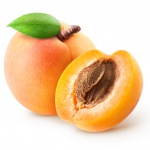 The apricot tree is a tree that can grow over 6 m tall. The branches are arranged forming a rounded cup. The trunk bark is brownish-violet and cracked. The branches are reddish and extended when young and the secondary branches are short, divergent and scarce. Latent buds are frequent especially on old branches. Leaves rolled up when young, smooth, bright, irregularly dentate, oval, a bit heart-shaped at the base, an acuminate apex, with the upper leaf surface of dark green colour and paler on the lower surface. Long petiole, grooved and glandy-like. Solitary, large flowers, with red calyx and white or pink petals. They appear in the spring before the leaves..
The apricot tree is a tree that can grow over 6 m tall. The branches are arranged forming a rounded cup. The trunk bark is brownish-violet and cracked. The branches are reddish and extended when young and the secondary branches are short, divergent and scarce. Latent buds are frequent especially on old branches. Leaves rolled up when young, smooth, bright, irregularly dentate, oval, a bit heart-shaped at the base, an acuminate apex, with the upper leaf surface of dark green colour and paler on the lower surface. Long petiole, grooved and glandy-like. Solitary, large flowers, with red calyx and white or pink petals. They appear in the spring before the leaves..
The fruit is a globose, yellow and very tasty drupe commonly known as apricot. More or less orange skin colour, dyed red in sun exposed areas, covered with a very fine pubescence and with a very marked groove, which extends from the peduncle to the opposite side. Pulp more or less adhered to the bone, more or less juicy and perfumed. The apricot tree is a quite rustic tree, typical of temperate climates, although it resists cold winters well. From its seeds, by cold pressing, we obtain oil with a profile of balanced fatty acids which provide a nutritional and repairing effect.
